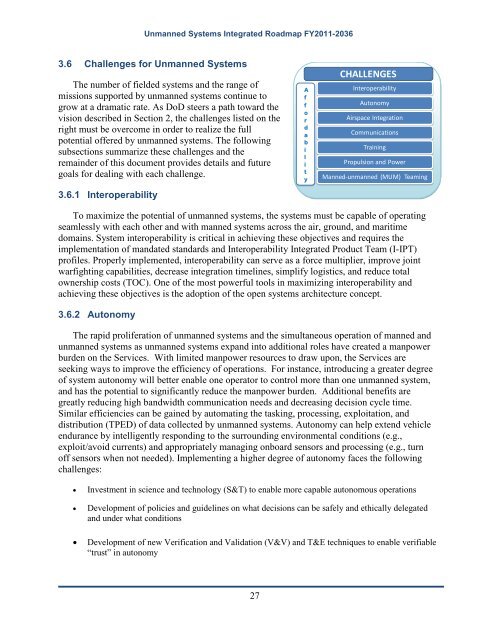Unmanned Systems Integrated Roadmap FY2011-2036 - Defense ...
Unmanned Systems Integrated Roadmap FY2011-2036 - Defense ...
Unmanned Systems Integrated Roadmap FY2011-2036 - Defense ...
You also want an ePaper? Increase the reach of your titles
YUMPU automatically turns print PDFs into web optimized ePapers that Google loves.
<strong>Unmanned</strong> <strong>Systems</strong> <strong>Integrated</strong> <strong>Roadmap</strong> <strong>FY2011</strong>-<strong>2036</strong><br />
3.6 Challenges for <strong>Unmanned</strong> <strong>Systems</strong><br />
The number of fielded systems and the range of<br />
missions supported by unmanned systems continue to<br />
grow at a dramatic rate. As DoD steers a path toward the<br />
vision described in Section 2, the challenges listed on the<br />
right must be overcome in order to realize the full<br />
potential offered by unmanned systems. The following<br />
subsections summarize these challenges and the<br />
remainder of this document provides details and future<br />
goals for dealing with each challenge.<br />
3.6.1 Interoperability<br />
27<br />
A<br />
f<br />
f<br />
o<br />
r<br />
d<br />
a<br />
b<br />
i<br />
l<br />
i<br />
t<br />
y<br />
CHALLENGES<br />
Interoperability<br />
Autonomy<br />
Airspace Integration<br />
Communications<br />
Training<br />
Propulsion and Power<br />
Manned-unmanned (MUM) Teaming<br />
To maximize the potential of unmanned systems, the systems must be capable of operating<br />
seamlessly with each other and with manned systems across the air, ground, and maritime<br />
domains. System interoperability is critical in achieving these objectives and requires the<br />
implementation of mandated standards and Interoperability <strong>Integrated</strong> Product Team (I-IPT)<br />
profiles. Properly implemented, interoperability can serve as a force multiplier, improve joint<br />
warfighting capabilities, decrease integration timelines, simplify logistics, and reduce total<br />
ownership costs (TOC). One of the most powerful tools in maximizing interoperability and<br />
achieving these objectives is the adoption of the open systems architecture concept.<br />
3.6.2 Autonomy<br />
The rapid proliferation of unmanned systems and the simultaneous operation of manned and<br />
unmanned systems as unmanned systems expand into additional roles have created a manpower<br />
burden on the Services. With limited manpower resources to draw upon, the Services are<br />
seeking ways to improve the efficiency of operations. For instance, introducing a greater degree<br />
of system autonomy will better enable one operator to control more than one unmanned system,<br />
and has the potential to significantly reduce the manpower burden. Additional benefits are<br />
greatly reducing high bandwidth communication needs and decreasing decision cycle time.<br />
Similar efficiencies can be gained by automating the tasking, processing, exploitation, and<br />
distribution (TPED) of data collected by unmanned systems. Autonomy can help extend vehicle<br />
endurance by intelligently responding to the surrounding environmental conditions (e.g.,<br />
exploit/avoid currents) and appropriately managing onboard sensors and processing (e.g., turn<br />
off sensors when not needed). Implementing a higher degree of autonomy faces the following<br />
challenges:<br />
• Investment in science and technology (S&T) to enable more capable autonomous operations<br />
• Development of policies and guidelines on what decisions can be safely and ethically delegated<br />
and under what conditions<br />
• Development of new Verification and Validation (V&V) and T&E techniques to enable verifiable<br />
“trust” in autonomy

















